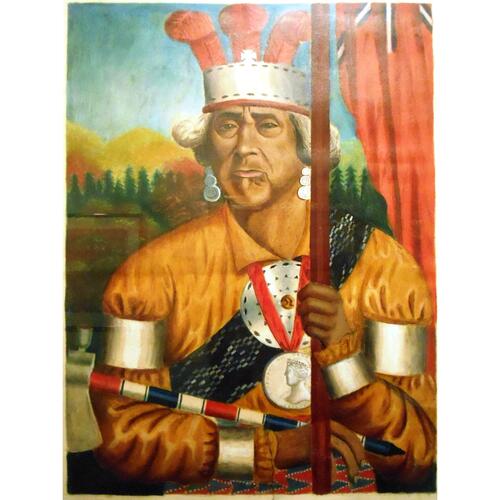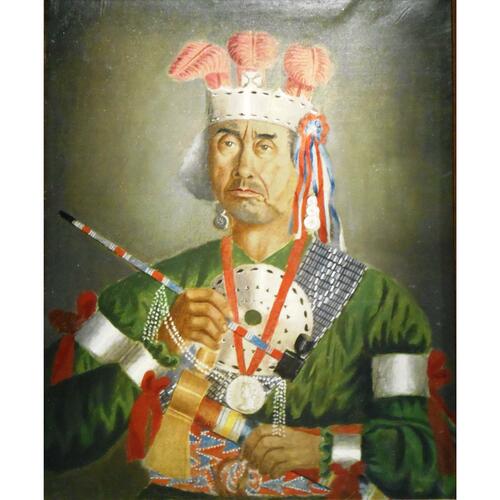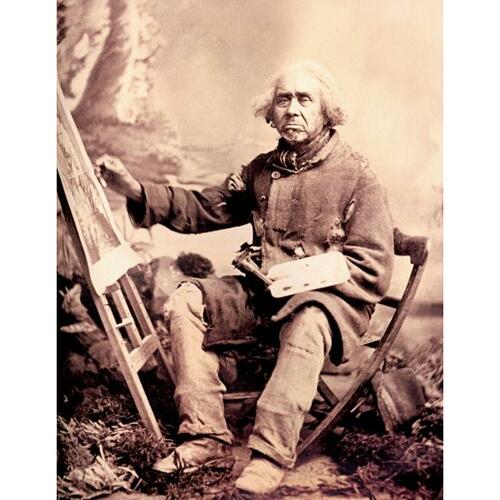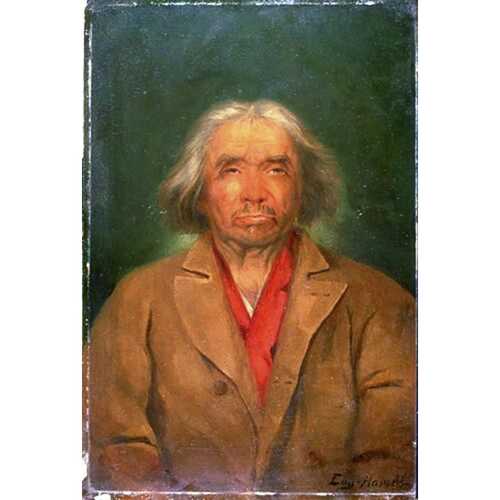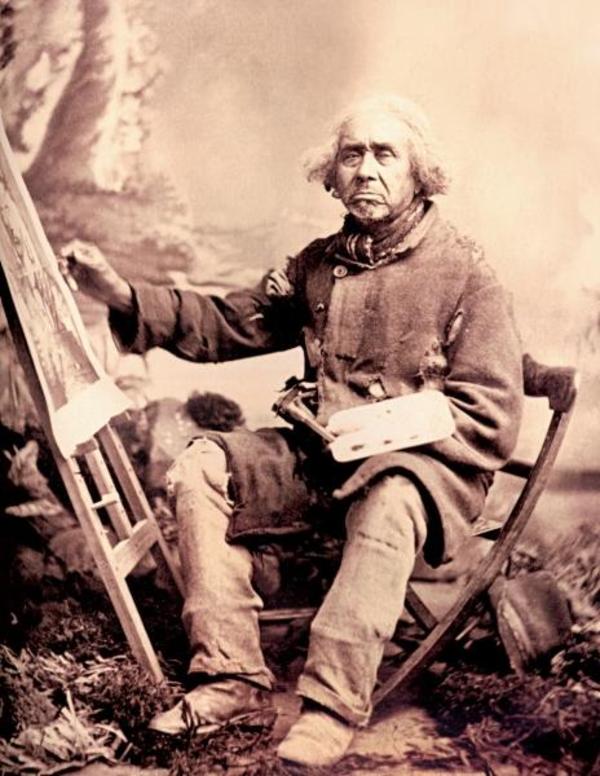
Source: Courtesy of Wikimedia Commons
VINCENT, ZACHARIE (Telari-o-lin), painter, sketch artist, and Huron (Wendat) chief; b. 28 Jan. 1815 at the Village-des-Hurons (Wendake), Lower Canada, son of Gabriel Vincent and Marie Otis (Otisse, Otesse, Hôtesse); m. 14 Aug. 1848 at Saint-Ambroise-de-la-Jeune-Lorette (Loretteville) Marie Falardeau (Falardau), Iroquois (Haudenosaunee) widow of Édouard-Sébastien Falardeau, and they had three sons and one daughter; d. 9 Oct. 1886 in Quebec City.
The meaning of Telari-o-lin, the Huron name of Zacharie Vincent, is uncertain. It has usually been translated as “not divided” or “unmixed”; the spelling varies according to the source. It could be derived from the Mohawk term Tekarioken, meaning “speech that divides in two when leaving the mouth.” Clearly a very gifted artist, he played a major role in preserving and promoting Huron culture, having grown up in a family who wished to pass on their traditions. His father Gabriel, whose Huron name was Ouenouadahronhé, was said to be “the only one who had retained his forefathers’ customs, and reared his family in [their] language, the younger inhabitants of the village at this time speaking only the French language.”
Zacharie Vincent’s own desire to perpetuate tradition, together with the attention he attracted from a number of his contemporaries in artistic and literary circles, contributed to his designation in the 19th century as the “last of the Hurons.” In 1838 the path followed by the 23-year-old Vincent came to a turning point. That year Antoine Plamondon*, who came from nearby Ancienne-Lorette (Que.), painted a full-length portrait of Vincent titled The last of the Hurons. The painting won Plamondon a medal from the Literary and Historical Society of Quebec and was acquired by Lord Durham [Lambton*], sent to London in 1840, and is now in the National Gallery of Canada’s collection in Ottawa. It inspired François-Xavier Garneau*’s poem “Le dernier Huron”: “Triumph, destiny / Your hour at last is come, / O nation, thou shalt be no more . . . .” The poet found in the subject’s face an “expression of thoughtful resignation.” The interest aroused by the theme of the impending loss of Huron culture was not unrelated to the similar expectation at the time that North American francophones would disappear. “May we erect a few monuments of ourselves before being drowned in the flood of immigration,” exclaimed a journalist upon seeing Plamondon’s portrait. A painting by Henry Daniel Thielcke*, done in 1840 and now in Montreal’s Château Ramezay Museum, shows Vincent with “headgear of his own making,” while the other eminent members of the Huron nation are wearing the tall beaver-skin hats of the colonizer. This distinction was a sign of “the historical memory of the race,” according to Abbé Lionel Lindsay.
Influenced by Plamondon’s canvas, Vincent began to paint self-portraits in a desire to reclaim his own image and keep alive the memory of his people. According to historiographical tradition, his training was limited to a few words of artistic advice from Plamondon. Vincent’s work falls into three main groups: portraits of himself in traditional dress, sketches depicting traditional activities of his people, and landscape paintings of Jeune-Lorette. Some of his canvases are in the Musée National des Beaux-Arts du Québec and others in the Musée du Château Ramezay. According to a contemporary source, Vincent produced more than 600 drawings and paintings, many of which were bought by governors general such as Lord Elgin [Bruce*], Lord Monck*, and Lord Durham, as well as by Princess Louise*, Marchioness of Lorne. Tradition also asserts that Vincent carved some small objects for the church of Notre-Dame-de-Lorette in the Village-des-Hurons, which are said to have been destroyed in the fire that devastated the building in 1959. Although intensely busy as an artist, Vincent also served his community. Beginning in 1845 he acted as war chief and then held the post of council head until 1879, before settling in Caughnawaga (Kahnawake).
Vincent wanted to preserve a traditional, authentic image of the Huron. He borrowed artistic elements used in Europe that can be seen in some of his paintings and sketches and reveal the mixing of cultures then taking place. In this way he attempted to overturn the romantic, nostalgic image of Indigenous cultures in the 19th century. Vincent’s work is undeniably raw, but intensity and sincerity give his work an enduring interest. His art reflects his desire to capture the spirit of a Huron America that seemed to be disappearing.
[We have been unable to identify any of Zacharie Vincent’s sculptures. A few of his paintings – self-portraits, landscapes, and scenes of Huron life – are on display at the Château Ramezay Museum in Montreal and the Musée National des Beaux-Arts du Québec in Quebec City.]
AC, Québec, État civil, Catholiques, Saint-Roch (Québec), 14 oct. 1886. AP, Saint-Ambroise (Loretteville), Reg. des baptêmes, mariages et sépultures, 15 févr. 1808, 28 janv. 1815, 23 nov. 1848, 20 juill. 1850, 3 juin 1852, 1er mai 1854. IBC, Centre de documentation, Fonds Morisset, 2, V775.5/Z16. F.-X. Garneau, “Le dernier Huron,” Le répertoire national ou recueil de littérature canadienne, James Huston, compil. (4v., Montréal, 1848–50), IV: 172–75. Le Canadien, 12 août 1840. Le Journal de Québec, 21 déc. 1878. Le Populaire (Montréal), 14 mai 1838. Star and Commercial Advertiser (Quebec), 8 April 1829. Mariages de Loretteville (St-Ambroise-de-la-Jeune-Lorette), 1761–1969, Village des Hurons (Notre-Dame-de-Lorette), 1904–1969, G.-E. Provencher, compil. (Québec, 1970). Harper, La peinture au Canada. L.-S.-G. Lindsay, Notre-Dame de la Jeune-Lorette en la Nouvelle-France, étude historique (Montréal, 1900). Gérard Morisset, La peinture traditionnelle au Canada français (Ottawa, 1960). Monique Duval, “Petit musée de la Huronnie à Loretteville,” Le Soleil (Québec), 23 août 1972: 20.
Bibliography for the revised version:
Louise Vigneault, “Zacharie Vincent: dernier Huron et premier artiste autochtone de tradition occidentale,” Mens (Montréal), 6 (2006): 239–61; Zacharie Vincent: une autohistoire artistique (Wendake, Québec, 2016).
Cite This Article
Staff of the DCB/DBC, “VINCENT, ZACHARIE (Telari-o-lin),” in Dictionary of Canadian Biography, vol. 11, University of Toronto/Université Laval, 2003–, accessed December 31, 2025, https://www.biographi.ca/en/bio/vincent_zacharie_11E.html.
The citation above shows the format for footnotes and endnotes according to the Chicago manual of style (16th edition). Information to be used in other citation formats:
| Permalink: | https://www.biographi.ca/en/bio/vincent_zacharie_11E.html |
| Author of Article: | Staff of the DCB/DBC |
| Title of Article: | VINCENT, ZACHARIE (Telari-o-lin) |
| Publication Name: | Dictionary of Canadian Biography, vol. 11 |
| Publisher: | University of Toronto/Université Laval |
| Year of publication: | 1982 |
| Year of revision: | 2023 |
| Access Date: | December 31, 2025 |


